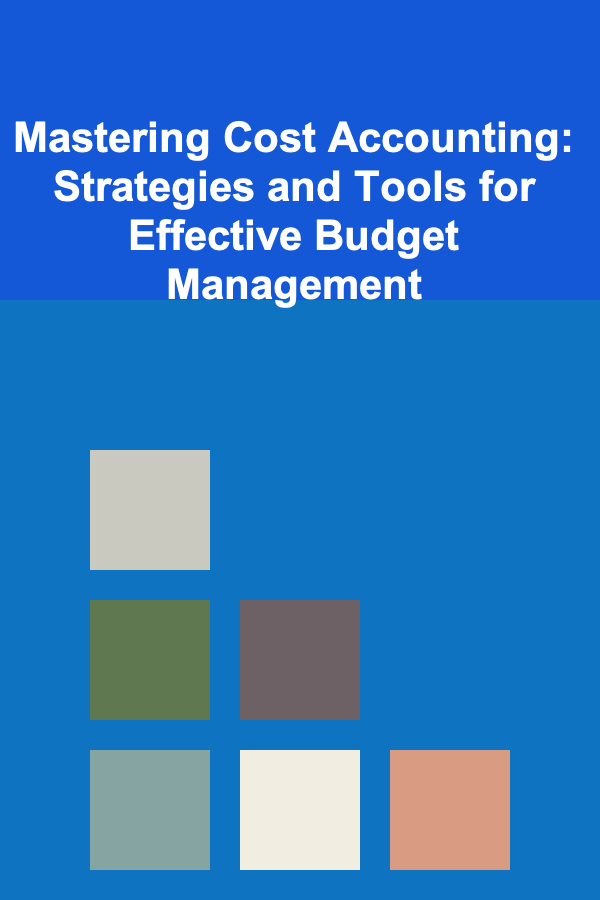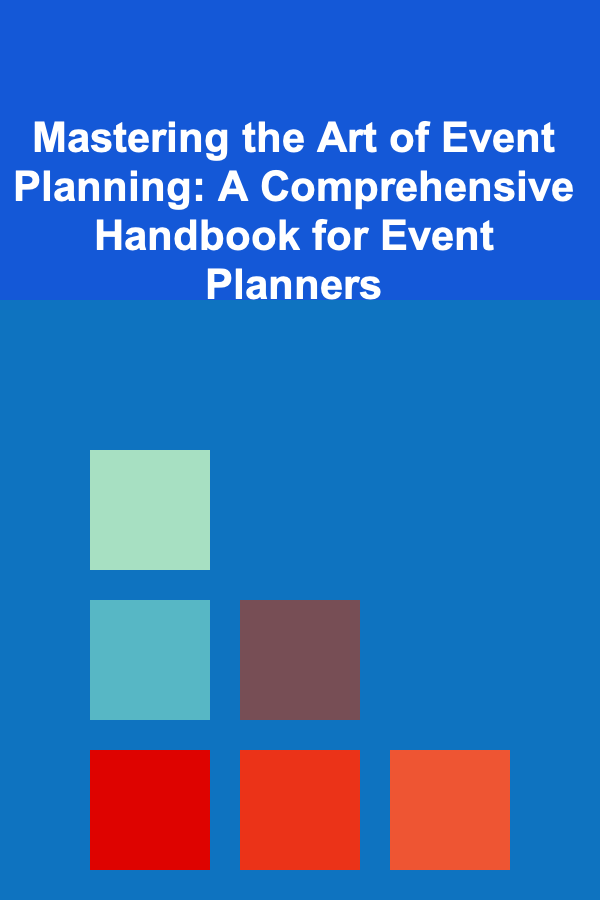
Mastering Cost Accounting: Strategies and Tools for Effective Budget Management
ebook include PDF & Audio bundle (Micro Guide)
$12.99$10.99
Limited Time Offer! Order within the next:

Cost accounting plays a pivotal role in helping organizations manage their expenses, optimize their financial resources, and improve profitability. Whether you're managing a small business or overseeing a large corporation, mastering cost accounting is essential for ensuring that budgets are set accurately, tracked meticulously, and adjusted as necessary to meet financial goals. This actionable guide explores the strategies and tools needed for effective budget management, focusing on best practices for cost accountants to contribute to the financial health of an organization.
Understanding the Role of Cost Accounting in Budget Management
Cost accounting involves the process of tracking, recording, and analyzing costs associated with the production of goods or services. It helps businesses determine the actual costs of their operations and identify areas where cost efficiencies can be improved. Cost accountants also play a critical role in budgeting, which involves forecasting revenues and expenses over a defined period and making strategic decisions to control costs effectively.
Effective budget management, therefore, relies heavily on accurate cost accounting data. By understanding the nuances of cost structures, identifying cost drivers, and applying the right costing methods, cost accountants ensure that budgets reflect the financial realities of the business. The following strategies and tools are essential for mastering cost accounting in the context of budget management.
Establishing Clear Costing Methods for Budgeting
One of the fundamental aspects of effective budget management is choosing the right costing method. Different organizations use different approaches to allocate costs based on their operational models. The appropriate costing method not only ensures accurate budgeting but also allows businesses to track and manage costs effectively. Below are the most commonly used costing methods that cost accountants should be familiar with.
2.1 Job Order Costing
Job order costing is used by businesses that produce unique or custom products for specific customer orders. It assigns costs to individual jobs, making it ideal for industries like construction, custom manufacturing, and consulting.
Best Practices for Job Order Costing:
- Tracking Direct and Indirect Costs: Ensure accurate allocation of direct materials, labor, and overhead costs to specific jobs.
- Accurate Job Cost Sheets: Develop detailed job cost sheets to track and manage each job's expenses, including materials, labor hours, and overhead.
- Analyzing Cost Drivers: Identify which activities or resources drive the costs for each job, and ensure these drivers are factored into the budgeting process.
2.2 Process Costing
Process costing is best suited for industries that produce homogeneous products on a continuous basis, such as chemical manufacturing or food production. It involves assigning costs to processes or production departments rather than individual units.
Best Practices for Process Costing:
- Cost Per Unit Calculation: Regularly calculate the per-unit cost of production, considering both direct and indirect costs.
- Cost Flow Assumptions: Use the appropriate cost flow assumption (FIFO, Weighted Average) to allocate costs across different batches or periods.
- Monitor Production Efficiency: Track production volumes and analyze how changes in production processes affect costs. Ensure that budgeting includes potential fluctuations in efficiency.
2.3 Activity-Based Costing (ABC)
Activity-Based Costing (ABC) is an advanced method that assigns costs based on the actual activities that generate them. ABC helps organizations better understand the indirect costs associated with their operations and allocate these costs more accurately.
Best Practices for Activity-Based Costing:
- Identify Key Activities: Break down the business processes into key activities (e.g., procurement, machine setup, quality control).
- Determine Cost Drivers: Analyze how each activity consumes resources and assign costs based on these drivers, such as machine hours or inspection time.
- Incorporate ABC into Budgeting: Use ABC data to allocate overhead more precisely in your budgets, ensuring that the costs of each activity are reflected accurately in financial plans.
Analyzing and Controlling Variances
One of the key roles of a cost accountant is to analyze variances---differences between actual costs and budgeted costs. Understanding and managing variances is essential for maintaining control over the budget and ensuring financial targets are met.
3.1 Types of Variances
There are several types of variances that cost accountants need to monitor:
- Material Variance: The difference between the actual cost of materials and the expected (standard) cost. This includes both price variance (how much the actual price deviates from the budgeted price) and usage variance (how much more or less material was used than expected).
- Labor Variance: The difference between the actual labor cost and the standard labor cost. This includes rate variance (how much the actual wage rate deviates from the expected wage rate) and efficiency variance (how much more or less labor time was required to complete a task).
- Overhead Variance: The difference between actual and budgeted overhead costs. Overhead can be fixed or variable, and the variance is broken down into controllable and uncontrollable portions.
3.2 Variance Analysis Process
- Tracking Variances: Regularly compare actual costs to the budgeted or standard costs to identify any discrepancies. This should be done for all major cost categories, such as materials, labor, and overhead.
- Identifying the Causes of Variance: Once a variance is detected, investigate the root cause. Is it due to inefficient production, incorrect forecasting, price fluctuations, or other factors?
- Taking Corrective Actions: After identifying the cause of the variance, take corrective action. This could involve renegotiating supplier contracts, adjusting production processes, or recalibrating labor schedules. Corrective actions should be aimed at bringing costs back in line with budget expectations.
Implementing Robust Budgeting and Forecasting Techniques
Budgeting is a dynamic process that requires constant adjustments to remain aligned with actual financial performance. Forecasting, which involves predicting future financial outcomes based on current and historical data, is an essential part of the budgeting process.
4.1 Developing a Realistic Budget
Creating a realistic budget is the foundation of good financial management. The budget must take into account all expected revenues and expenses, both fixed and variable. It should also reflect seasonal fluctuations, market trends, and other factors that could impact financial performance.
Key Steps in Budgeting:
- Set Clear Financial Goals: Align the budget with the organization's financial objectives. Whether it's increasing profitability, reducing costs, or expanding operations, the budget should reflect these goals.
- Use Historical Data: Leverage past financial data to make more accurate forecasts for revenue and expenses. Historical data helps predict future trends, such as production costs or sales figures.
- Incorporate Flexibility: Build flexibility into the budget by including contingency plans and considering different scenarios. This allows for adjustments when unexpected events occur, such as market downturns or supply chain disruptions.
4.2 Forecasting for Uncertainty
Forecasting is a proactive tool that helps businesses anticipate future costs, revenues, and profits. Accurate forecasting allows businesses to adjust their budgets before financial challenges arise, ensuring that they remain on track to meet their objectives.
Key Steps in Forecasting:
- Utilize Statistical Methods: Use historical data to identify trends and apply forecasting techniques, such as moving averages or regression analysis, to predict future outcomes.
- Scenario Planning: Develop multiple forecasts based on different assumptions (e.g., best-case, worst-case, and most likely). This helps businesses prepare for a range of possible outcomes.
- Regular Updates: Continually update forecasts as new data becomes available. Regular updates allow businesses to adjust their strategies and budgets as needed to stay on course.
Leveraging Technology for Effective Budget Management
In the modern era, cost accountants must leverage technology to enhance their ability to manage budgets effectively. Tools like Enterprise Resource Planning (ERP) systems and data analytics platforms provide real-time data, enabling more accurate decision-making.
5.1 Enterprise Resource Planning (ERP) Systems
ERP systems integrate key business functions, including finance, operations, and inventory management, into a unified platform. These systems allow cost accountants to access real-time data, track costs, and generate financial reports more efficiently.
Key Benefits of ERP for Budget Management:
- Centralized Data: ERP systems provide a single source of truth for financial data, ensuring that cost accountants can easily access and analyze relevant information.
- Automation: Many tasks, such as data entry, cost allocation, and reporting, can be automated, saving time and reducing the potential for errors.
- Real-time Reporting: ERP systems provide up-to-the-minute reports on costs, revenues, and other key financial metrics, allowing businesses to make informed decisions quickly.
5.2 Data Analytics and Business Intelligence
Data analytics platforms, such as Power BI and Tableau, help cost accountants visualize complex financial data, identify trends, and make data-driven decisions. These platforms enable cost accountants to present their findings in a more accessible way for management, making it easier to communicate insights and recommendations.
Key Benefits of Data Analytics for Budgeting:
- Predictive Insights: Data analytics tools can help forecast future costs and revenues based on historical data and current trends.
- Visualization: Dashboards and visual reports make it easier for stakeholders to understand the financial data, identify issues, and make informed decisions.
- Trend Analysis: Data analytics allows businesses to identify patterns and trends that may not be immediately obvious, helping them anticipate challenges and adjust budgets accordingly.
Conclusion
Mastering cost accounting is an essential skill for managing budgets effectively. By choosing the right costing methods, analyzing variances, implementing sound budgeting and forecasting practices, and leveraging technology, cost accountants can provide valuable insights that drive financial success. Through careful cost control, effective budget management, and the use of advanced tools, businesses can ensure that they stay on track to meet their financial goals, optimize their resources, and remain competitive in their industry.

How to Build an Emergency Fund: Steps to Get Started
Read More
How to Make a Checklist for Handling International Freight Forwarding
Read More
How to Profit from Deep Learning Models in the Freelance World
Read More
How to Stage Your Home for a Fast, Stress-Free Move
Read More
How to Use a Grocery Shopping Checklist to Prevent Food Waste
Read More
Mastering the Art of Event Planning: A Comprehensive Handbook for Event Planners
Read MoreOther Products

How to Build an Emergency Fund: Steps to Get Started
Read More
How to Make a Checklist for Handling International Freight Forwarding
Read More
How to Profit from Deep Learning Models in the Freelance World
Read More
How to Stage Your Home for a Fast, Stress-Free Move
Read More
How to Use a Grocery Shopping Checklist to Prevent Food Waste
Read More